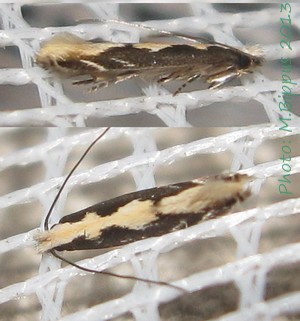
Amphixystis is a genus of moths belonging to the family Tineidae. The family was first described by Edward Meyrick in 1901.

Parienia is a genus of moths belonging to the subfamily Olethreutinae of the family Tortricidae. This genus was described by Edward Meyrick in 1881. It consists of only one species, Parienia mochlophorana, which is endemic to New Zealand.

Eudonia alopecias is a moth in the family Crambidae. It was described by Edward Meyrick in 1901. It is endemic to New Zealand and has been found at Aoraki / Mount Cook in February.
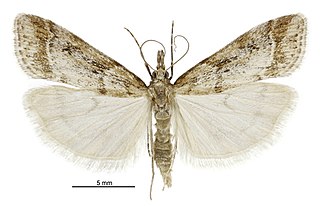
Eudonia chalara is a moth in the family Crambidae. It was described by Edward Meyrick in 1901. It is endemic to New Zealand.
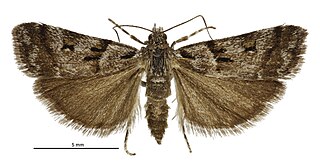
Eudonia organaea is a moth in the family Crambidae. It was described by Edward Meyrick in 1901. It is endemic to New Zealand.

Eudonia torodes is a moth in the family Crambidae. It was described by Edward Meyrick in 1901. It is endemic to New Zealand.
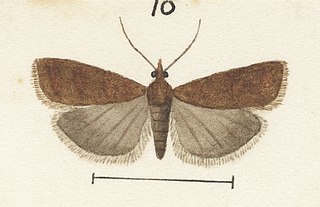
Scoparia parachalca is a moth in the family Crambidae. It was described by Edward Meyrick in 1901. It is endemic to New Zealand.

Kiwaia hippeis is a moth in the family Gelechiidae. This species was first described by Edward Meyrick in 1901. It is endemic to New Zealand and has been collected in Christchurch. Adults of this species are on the wing in December and are attracted to light.
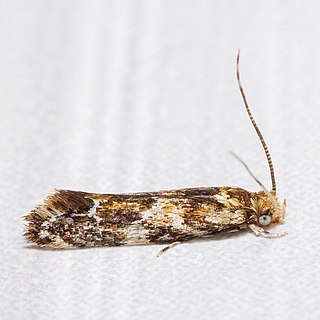
Dryadaula pactolia is a species of moth in the family Tineidae. It was described by Edward Meyrick in 1901. This species is endemic to New Zealand. but it is occasional in Europe The larva feeds on the fungus Zasmidium cellare found in wine cellars and breweries.
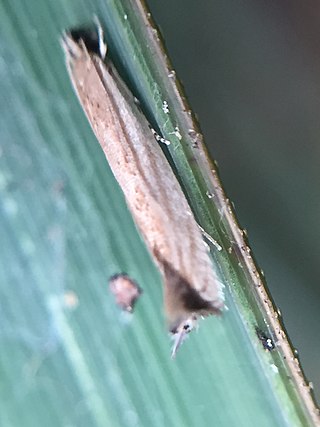
Erechthias exospila is a species of moth in the family Tineidae. It was described by Edward Meyrick in 1901 using a specimen he collected in Whangārei in December. This species is endemic to New Zealand.

Tingena is a genus of the concealer moth family (Oecophoridae). This genus is endemic to New Zealand.
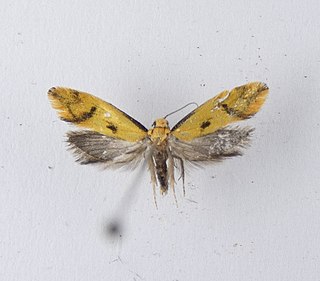
Tingena actinias is a species of moth in the family Oecophoridae. It is endemic to New Zealand and is found on the North and South Islands. The larvae of this species are leaf litter feeders. The preferred habitat of this species is shrubland and it has also been observed in gumland heaths and in beech forest.

Tortrix fervida is a species of moth of the family Tortricidae. It is endemic to New Zealand and has been observed in both the North and South Islands. The larvae feed on species of fern in the genus Hymenophyllum including Hymenophyllum nephrophyllum. The adult moths are variable in appearance and are day flying. They are on the wing from November until January. This species is regarded as being uncommon.

Chrysorthenches porphyritis is a species of moth of the family Plutellidae. It was first described by Edward Meyrick in 1885 and is endemic to New Zealand. This species can be found on both the North and South Islands in open native forest and scrub at altitudes from sea level up to 1370 m. The larvae feed on Podocarpus laetus, P. totara, P. nivalis, and Phyllocladus alpinus. The larvae create a shelter by loosely spinning together the leaves of its host plant and can be found feeding in groups. The pupa is formed inside a thin cocoon. Hudson was of the opinion that this species had two broods a year. Adult moths are on the wing all year round. The adults of this species, particularly the female, are variable in colouration and in forewing pattern.
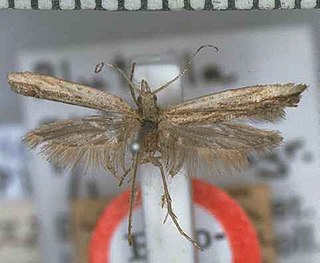
Plutella antiphona, also known as the diamondback moth, is a moth of the family Plutellidae first described by Edward Meyrick in 1901. It is endemic to New Zealand.

Amphixystis paraglypta is a species of moth in the family Tineidae first described by Edward Meyrick in 1889. It is endemic to New Zealand.

Holocola emplasta is a species of moth in the family Tortricidae. It is endemic to New Zealand.

Holocola parthenia is a species of moth in the family Tortricidae. It is endemic to New Zealand.


















